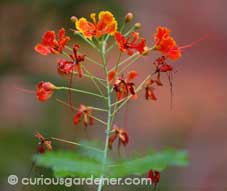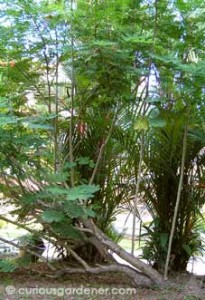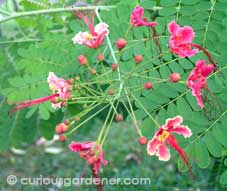My interest in growing plants began about 8 years ago when I first set eyes on the Peacock tree. The amazing colours of the flowers caught my attention, and I knew I had to have them growing in our garden.
Peacock trees were the rage at the time, so they were everywhere. I managed to snare pods from a friend’s neighbour and from a roadside tree, and proceeded to attempt to sprout them. It was fairly easy and I found myself with too many seedlings. So, I planted a couple where I wanted them to be, and I planted the rest in different locations to see how they would fare.
They fared well. So well that I had one that I called my “experimental” tree. It survived being moved to two different locations when it was fairly mature, and proved it’s survival status when I beheaded it so there was only one foot of the stem left, with no leaves. My intention was to get a bushier plant out of it.
To my great delight, it did exactly that, and eventually grew into a big, bushy tree.
Problems with the trees
I suppose Peacock trees are naturally scraggly-looking for a reason. They don’t have deep roots, and two of my trees fell over after heavy rain made them top-heavy. We pruned them down and righted them, and they continued growing happily. However, they need constant trimming to keep down their upper weight.
My experimental tree went through another unplanned experiment. It toppled over three times, and after the last time, I thought perhaps it was time to say goodbye to it. I mulled over that for over a week because I was quite fond of it — and I guess I was trying to delay having to get near it with shears.
Peacock trees have notoriously thorny branches. The thorns on the green branches are as sharp as needles, and when the branches become woody, they become only slightly less sharp. Pruning Peacock trees is not one of my favourite tasks! In fact the only possible nice thing about pruning them is the pleasant scent of the cut branches.
Since that tree was more than a storey high when it fell over, we did the pruning over several days, a bit at a time. In the duration, the tree was busily adapting to its new circumstances. It was lying on it’s side, and began to take root where the trunk touched the ground. It also sprouted new branches from the now horizontal trunk. I noticed all this and decided to see how this would turn out. Unexpectedly, we found ourselves with nice, thick foliage from a single tree, that since it was more securely rooted, was more stable than before.
Visitors to the Peacock tree
Many birds like the Peacock tree. It provides a shaded perch to sparrows and sunbirds, and a source of food to other takers. Green parakeets visit often to snack on the beans produced by the tree. They are adept at plucking the pods and prying them open to eat the beans inside. Their colour camouflages them well, and they are quiet and rather shy creatures. You know when they’ve visited when you see a lot of eaten pods scattered beneath the trees!
Another creature that came for food was a plantain squirrel. It liked the dried bean pods, and visited for about a fortnight until it became roadkill. We don’t know where it originated from because it was the first and last squirrel we’d seen.
Peacock tree flowers
I mentioned that I had been initially attracted to the Peacock tree because of the flowers. The main varieties are yellow, orange and pink. Since I found yellow common, I chose to get the orange and pink varieties. The gorgeous thing about the flowers is the beautiful colour pallette.
Orange flowers have yellow edges to the petals and deep red stamens topped with bright yellow anthers. Pink flowers have the same stamens and anthers, and the petals have a pale pink edging, with one yellow petal in the middle. When the trees flower, they are absolutely beautiful, and they bloom all year round! I definitely have no regrets adding these beauties to our garden.
© 2010 curiousgardener.com All rights reserved.





